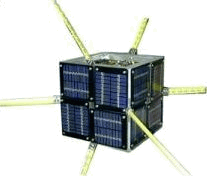 NAV OSCAR 44 – PCSat (Recovery)
NAV OSCAR 44 – PCSat (Recovery)
Starting Monday Morning (Dec 26, 2011), I will be trying to recover PCSAT. We need everyone to not use it until we give up. Just one single packet from a user during a pass will easily kill that pass’s chance of recovery. We only get one single packet chance per pass for recovery. Only when the call PCSAT-1 is readable in the beacon, the digipeater is active. So everyone, turn off those automatic beacons via PCSAT until further notice.
Thanks
Bob, WB4APR

Almost recovered. Mike (DK3WN) got command over Germany but it did not hold.
At 1300z pass over east coast, I got 3 telemetry packets, 5, 6 and 8 minutes into the pass with Latitude between 29N and 39N. The first packet showed +Z (best panel) current was 93 mA.
Above that latitude, packets got weaker.
One person got a perfect digipeat just about when I was going to try to command at 7 minutes into the pass. So I waited 1 minute and tried to COMMAND at 8 minutes into the pass, but it killed it. No response after the first ACK.
TLM did not appear again until 10 minutes into the pass. But +Z current was down to 59 mA. Only decoded that one packet for the rest of the pass.
WE MUST GET EVERYONE TO STOP TRYING TO DIGIPEAT. Chances are, that one successful user packet should have been mine for control, it was at the right time, and best sun angle. It used up all the power and so I had to wait another minute, but by then the power had dropped.
Bob, WB4APR
[PE0SAT thanks Bob, WB4APR for the above information]
PCSAT SUMMARY and SOLICITATION: Our PCSAT recovery attempt this week was
unsuccessful this time, but she will be back to normal (intermittent, weak)
operation in a few weeks.
BACKGROUND: PCSAT is functional a few times a day in the northern
hemisphere year round. You can see its telemetry and user activity on
http://pcsat.aprs.org . But it dies every orbit in eclipse because it
defaults with backup systems turned ON. We can turn them off, but it can
only really get enough charge to survive and keep them off during periodic
full-sun periods that only happen once or twice a year in winter.
PCSAT has a permanent +/-Z magnet for alignment with the Earth’s field and a
0.6 RPM spin (solar pressure about Z). The best solar panel is on the -Z
(south seeking axis). On the 4 sides are our cheap plastic covered cells
and there are no panels on +Z.
With a 63 degree inclined orbit, PCSAT enters a full sun period about once
every 3 months. PCSAT can be fully operational during those periods and
beyond if we can get command and turn off unnecessary redundant loads.
The problem is that the times when we get peak sun (peak power) on the BEST
panel is when we are also experiencing maximum eclipses. SO we can command
easily (peak power available for a packet), but with only 45 minutes charge
time, cannot then last through the following 35 min eclipse (minimum average
power available).
On the other hand, when we have full sun and there are no eclipses (plenty
of average power), there is no sun on the -Z face to give us the peak power
we need for the few seconds to complete the packet command sequence.
What this means is that we really only have one or two days out of the 1 or
2 week full sun windows to get command, and only in winter. Because each
orbit as we approach the terminator is getting less and less peak power, but
recovering it before full-sun cannot be sustained due to low average power.
VOLUNTEER STUDENT PROJECT?
Anyway, the offset between the earth’s magnetic and geometric poles,
suggests there are several degrees of variation in the -Z sun power
depending on WHERE the commanding ground station is relative to the time of
day and orbit plane with respect to magnetic North. Using simple geometry,
I have estimated our best command opportunity from Maryland is when the
satellite crosses about 35 deg N latitude and to our east in the morning as
the orbit approaches full sun. But I have no comprehensive math model to
then predict other optimum times for other potential command locations.
DK3WN’s ground station in Germany I think, sees a little bit better angle
differentiation due to his being perpendicular to the line between the
magnetic and geographic poles, but I would like to have a good formal
analysis of this geometry to better be able to coordinate our commanding.
When commanding, one only gets one attempt per orbit per day. If it fails
due to lack of peak power, then the load of the satellites attempted
response and RETRIES kills the batteries for that orbit.
Anyway, working all of this out with a math model and plots so we can
predict these optimum times would be a great benefit to our decade old
satellite (the longest operational student project satellite).
Bob, WB4APR
USNA Sat Lab
[PE0SAT thanks Bob, WB4APR for the above information]